NCERT Solutions for Class 6 Science Chapter 2 - Diversity in the Living World
The NCERT Solutions for Class 6 Science Chapter 2 - Diversity in the Living World deals with the wide variety found in nature. Different features of plants and animals, and how they help preserve the ecosystem, are covered. It also explains how classifying living organisms makes it easier to study and research. All the answers are provided with clear and simple language, making revision smooth. The NCERT Solutions are beneficial to students if they practice them regularly.
This Story also Contains
- Download Diversity in the Living World NCERT Solutions PDF
- Access Class 6 Science Chapter 2 - Diversity in the Living World Solutions
- Approach to Solve Diversity in the Living World Class 6 Question Answer
- Important Topics of Class 6 Science NCERT Chapter 2
- Important Question from Class 6 Science Chapter 2
- What You Will Learn from Diversity in the Living World NCERT Solutions
- NCERT Solutions for Class 6 Science: Chapter-wise
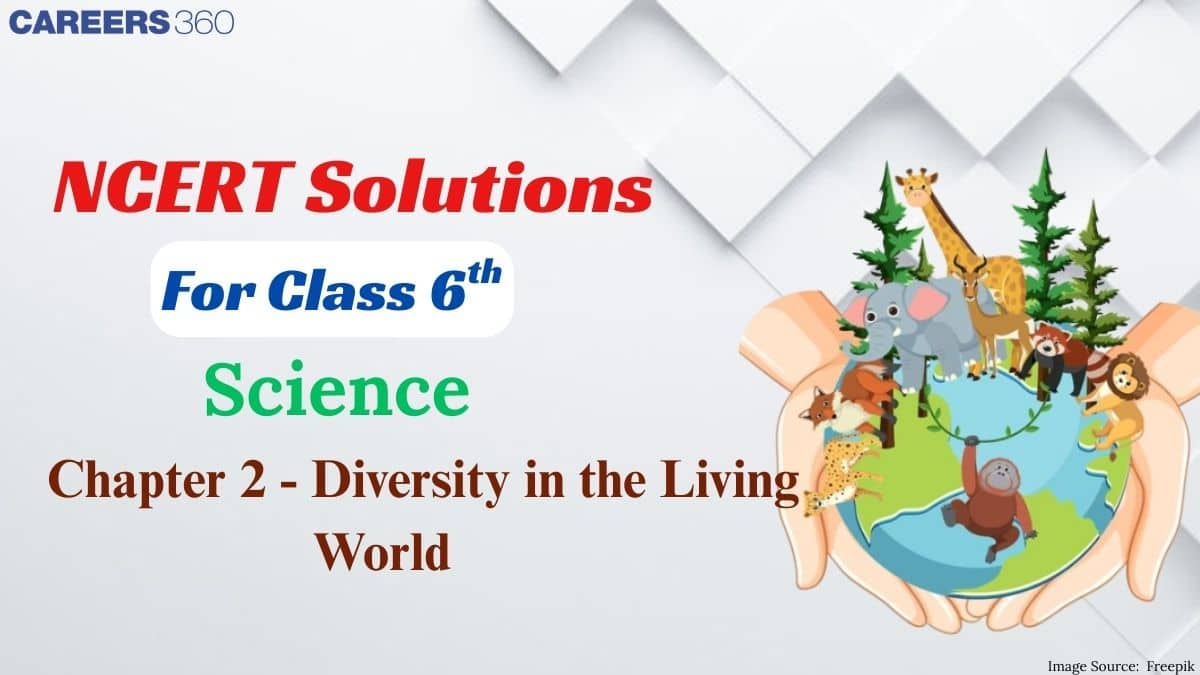
Diversity in the Living World NCERT Solutions offer detailed answers and well-labeled diagrams. This helps students understand animal and plant classification, adaptations, and characteristics. Constant practice using the Diversity in the Living World class 6 question answer removes doubts and increases confidence. Students can also refer to the NCERT Solutions for Class 6 Science to practice questions and gain clarity.
Download Diversity in the Living World NCERT Solutions PDF
The PDF format helps students study in a more flexible way as it can be opened anytime on a phone, tablet, or computer, even without internet. The Class 6 Science Chapter 2 - Diversity in the Living World question answer PDF makes it easier to revise important topics. The NCERT Solutions for Class 6 are useful during last-minute preparation to prepare better.
Access Class 6 Science Chapter 2 - Diversity in the Living World Solutions
The exercise below will help students in revising the concepts covered in Diversity in the Living World. The class 6 science Chapter 2 - Diversity in the Living World solutions follow the latest NCERT syllabus, by which they know how organisms are classified and their characteristics.
Question 1. Here are two types of seeds. What differences do you find among the roots and leaf venation of their plants?
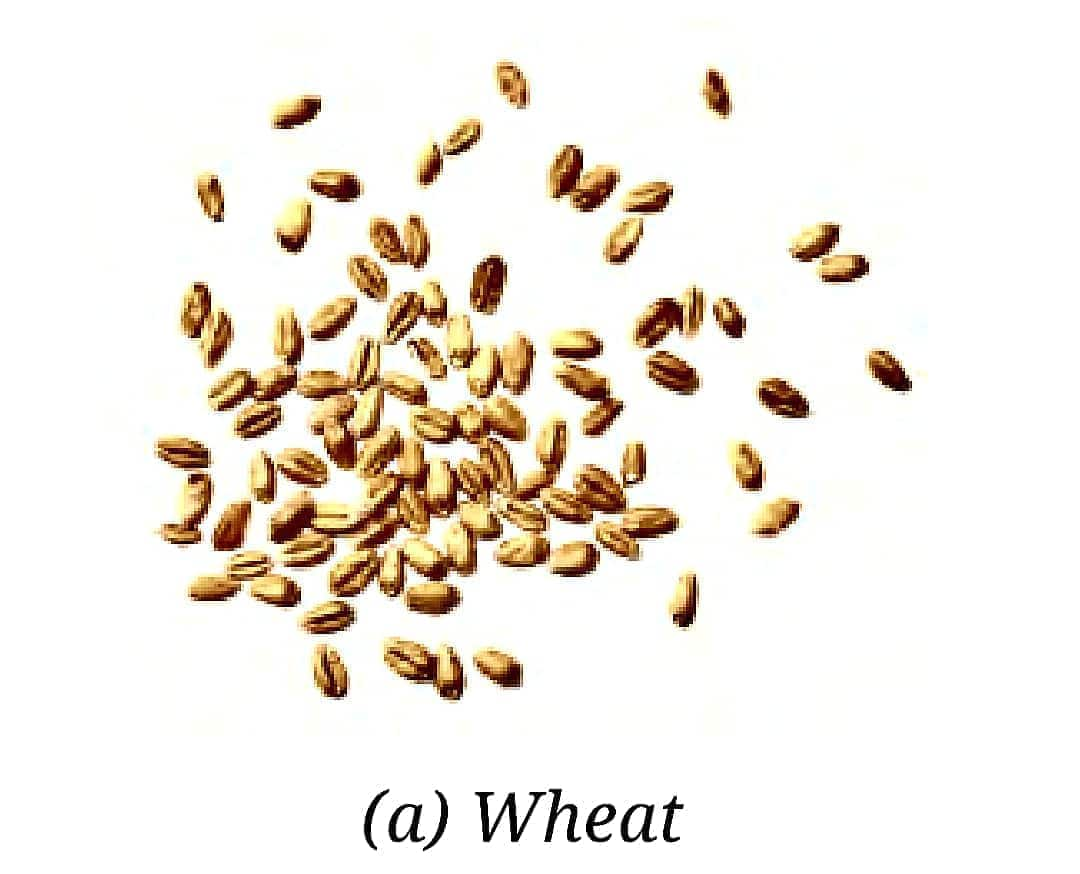
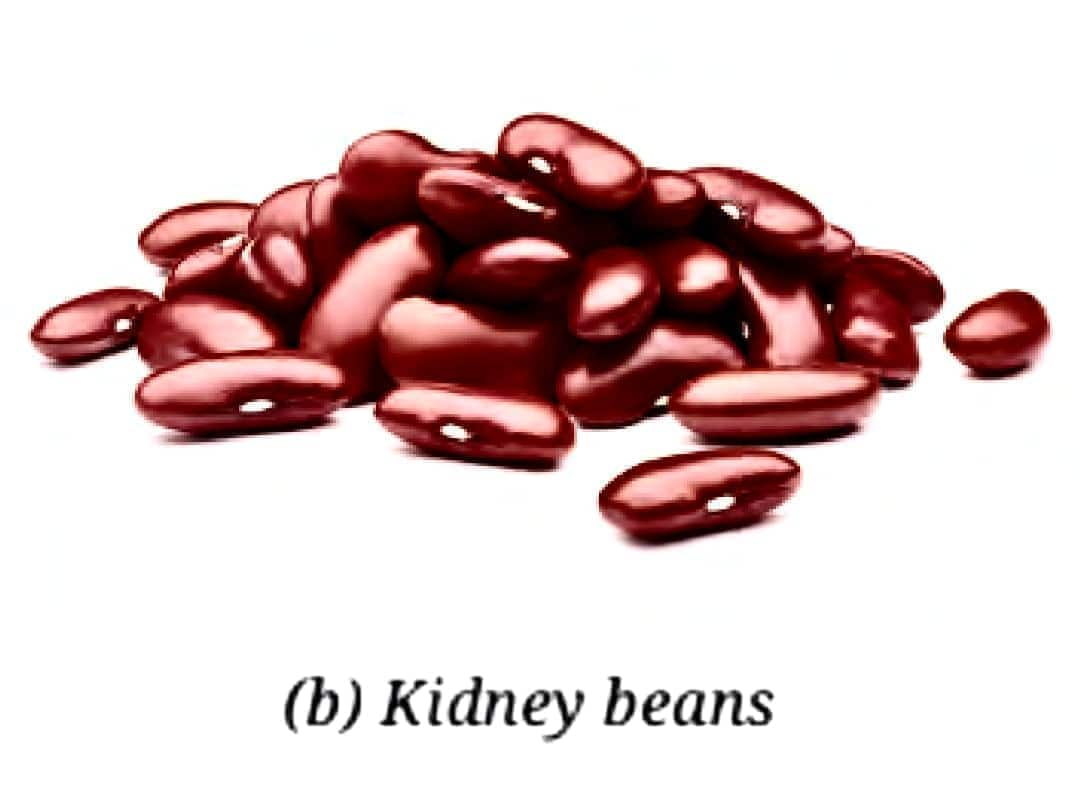
Answer:
The first seed given is of wheat, which is one of the most important stable crops worldwide.
Roots: Wheat plants have a fibrous root system. The roots arise from the base of the stem and are thin and spread out in all directions, forming a dense network of small roots.
Leaf Venation: Wheat leaves have parallel venation, in which the veins run parallel to each other in the leaf.
The second seed is kidney beans, which are rich in protein, fiber, and essential minerals.
Roots: Kidney beans have a tap root system, where the primary root grows thicker and deeper, and the small branches arise from this.
Leaf Venation: Kidney beans have a reticulate type of leaf venation, where the veins form a network or a web-like structure across the leaf.
Question 2. The names of some animals are given below. Group them based on their habitats. Write the names of aquatic animals in the area marked ‘A’ and terrestrial animals in the area marked ‘B. ’ Enter the names of animals living in both habitats in part C. Horse, Dolphin, Frog, Sheep, Crocodile, Squirrel, Whale, Earthworm, Pigeon, Tortoise
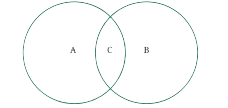
Answer:
A (Aquatic Animals):
-
Dolphin
-
Whale
B (Terrestrial Animals):
-
Horse
-
Sheep
-
Squirrel
-
Pigeon
-
Earthworm
-
Tortoise
C (Animals living in both habitats):
-
Frog
-
Crocodile (can live in both water and on land)
Question 3. Manu’s mother maintains a kitchen garden. One day, she was digging out radishes from the soil. She told Manu that radish is a kind of root. Examine a radish and write what type of root it is. What type of venation would you observe in the leaves of the radish plant?
Answer:
The radish is an example of a taproot. In this, the plant has a thick main root called the primary root and bears many side branches called secondary roots. In the radish plant, it helps in the storage of various sugars and starches, making it an important food source for us.
The leaves of the radish plant show reticulate venation. In which veins are irregularly distributed in the lamina, forming a network. This reticulate venation is mostly found in dicot plants.
Question 4. Look at the image of a mountain goat and a goat found in the plains. Point out the similarities and differences between them. What are the reasons for these differences?
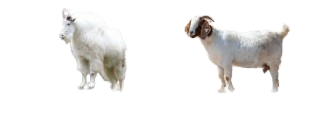
Answer:
Similarities: Given below are some of the similarities found in the mountain goat and the goat found in the plains:
1- Both belong to the same kind of family; that is, both are goats.
2- Mountain goats and goats found in plains are herbivores, meaning they eat grass, leaves, and plants.
3- Both have horns on their head, despite their size and structure.
4- Both goats are mammals, meaning they give birth to their young and give milk.
Differences: There are some differences between these two types of goats, which are provided here:
1- Mountain goats have thick fur, which protects them from the cold and snow. Goats in the plains have thin fur as it is warm in the plains.
2- Mountain goats live alone or in small groups, whereas the goats in the plains live in larger groups.
3- The size of mountain goats is generally smaller than that of the goats in the plains.
4- Mountain goats can easily climb steep hills, but goats in the plains are more used to grazing on flat ground.
Question 5. Group the following animals into two groups based on any feature other than those discussed in the chapter— cow, cockroach, pigeon, bat, tortoise, whale, fish, grasshopper, lizard.
Answer:
Apart from the feature that has already been discussed in this chapter, we can classify these animals based on the presence or absence of a backbone.
Animals having backbone
-
Cow
-
Pigeon
-
Bat
-
Tortoise
-
Whale
-
Fish
-
Lizard
Animals without a backbone
-
Cockroach
-
Grasshopper
Question 6. As the population grows and people want more comfortable lives, forests are being cut down to meet various needs. How can this affect our surroundings? How do you think we can address this challenge?
Answer:
As the population is growing, forests are being cut on a large scale, which is known as deforestation, to meet various needs. Here are some effects of this:
-
It leads to soil erosion, which results in the loss of the fertile layer of soil.
-
Deforestation also disturbs the habitat of many wild animals, birds, and insects.
-
Deforestation may lead to frequent floods as there are no trees and their roots to absorb rainwater.
There are some ways by which we can address this challenge:
-
We need to plant trees around us.
-
Natural resources like wood can be used carefully.
-
By using eco-friendly products that do not harm the environment.
-
Avoid using plastic bags as they do not decompose easily and cause pollution.
Question 7. Analyze the flowchart. What can be examples of ‘A’ and ‘B’?
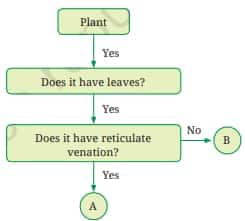
Answer:
According to the above flow chart, plants having leaves and reticulate venation can be dicot plants, as this type of venation is unique in dicot plants.
Plants having leaves but not the reticulate venation must be the monocot plants because this venation cannot be seen in monocot plants.
A- Dicot Plant
B- Monocot Plant
Question 8. Raj argues with his friend Sanjay that the “Gudhal (hibiscus) plant is a shrub.” What questions can Sanjay ask for clarification?
Answer:
Sanjay can ask multiple questions of Raj to clarify his argument. Provided below are some of the questions:
1- What is the definition of a shrub?
2- How is a hibiscus plant different from a tree?
3- Can a hibiscus plant grow tall or stay small?
4- Is the hibiscus plant woody or soft?
Question 9. Based on the information in the table, find examples of these plants for each group.
|
Group |
Type of Seed |
Type of Root |
Examples |
|
A |
Dicot |
Taproot | |
|
B |
Monocot |
Fibrous roots |
(a) What other similarities do plants of group A have?
(b) What other similarities do plants of group B have?
Answer:
|
Group |
Type of Seed |
Type of Root |
Examples |
|
A |
Dicot |
Taproot |
Kidney Bean |
|
B |
Monocot |
Fibrous roots |
Wheat |
(a) Dicot plants having taproots have some similarities that include the seeds having two cotyledons and reticulate venation found in leaves.
(b) Group B, having Monocot seed and fibrous roots, has one cotyledon in their seeds and leaves have parallel venation.
Question 10. Observe the labelled part of a duck in the picture given below. What differences do you observe in the feet of the duck compared to the other birds? Which activity would the duck be able to perform using this part?
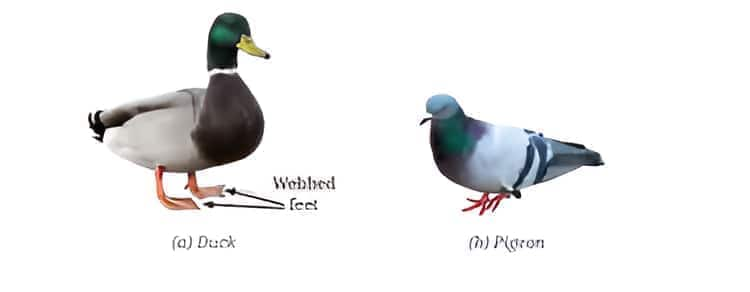
Answer:
The labelled part of the duck is its webbed feet, which are different from the feet of other birds. The toes of ducks have skin in between that forms a ‘web, ’ which is not present in other birds. Other ones have individual toes without any skin present.
This helps the duck to swim and move easily in water. When the duck moves with its webbed feet, a lot of water is pushed backward, which allows the duck to move quickly forward; that is why ducks are very good swimmers.
Also, check the NCERT Books and the NCERT Syllabus here
Approach to Solve Diversity in the Living World Class 6 Question Answer
To answer Diversity in the Living World questions, simply apply the following steps:
-
Read the chapter to learn about the diversity and classification of plants and animals surrounding us.
-
Observe distinguishing features such as stem type, leaves, flowers, and habitats for classifying organisms. All these features are well-explained in the Class 6 science Chapter 2 - Diversity in the Living World solutions.
-
Practice classifying and grouping examples based on similarities and differences between living organisms.
-
Rewrite definitions and key terms such as biodiversity, adaptation, and classification.
-
Study the Class 6 Science Chapter 2 - Diversity in the Living World question answer to strengthen the understanding and answer-writing ability.
Important Topics of Class 6 Science NCERT Chapter 2
Given below are the important topics covered in Chapter 2. Questions are frequently asked based on these concepts. To gain clarity and boost confidence, students can refer to the NCERT Solutions for Class 6 Science Chapter 2 - Diversity in the Living World.
1. It includes the diversity of plants and animals that are present around us.
2. Classification and grouping of organisms based on similarities and differences are highlighted in Chapter 2.
3. Grouping of plants based on their roots, stems, leaves, and flowers is well-explained, along with diagrams.
4. Adaptations in animals, such as camels, and plants, such as Rhododendrons, are also provided in this chapter.
Important Question from Class 6 Science Chapter 2
To understand how questions are framed in the exam, it is important to practice questions. Given below is a question along with the answer. More such questions are added in the NCERT Solutions for Class 6 Science Chapter 2 - Diversity in the Living World.
Question 1: Which of the following is an example of a herb?
a) Mango
b) Mint
c) Rose
d) Neem
Answer: b) Mint
Explanation:
Mint (genus Mentha) is an example of a herb because it is a small, aromatic, and soft-stemmed plant that typically grows close to the ground. Unlike trees such as mango or neem, which have woody stems, herbs like mint have non-woody stems and are often used for culinary, medicinal, and aromatic purposes. Mint plants are perennial herbs known for their distinctive fragrance and are widely used in cooking and herbal remedies. This distinguishes mint clearly as a herb, while mango, rose, and neem are trees or shrubs with woody stems.
What You Will Learn from Diversity in the Living World NCERT Solutions
Learning about the living world helps students know more about plants, animals, and their surroundings. It makes them understand how all living things are different but still connected to each other. Some things that students will learn by using the solutions are given below:
-
Living things are of many types, and each has unique features.
-
Plants and animals are grouped to make the study easier and simpler.
-
Animals live in different places, like land, water, or both.
-
Taking care of nature is important because it gives us food, water, and shelter.
NCERT Solutions for Class 6 Science: Chapter-wise
Below are the chapter-wise solutions:
Frequently Asked Questions (FAQs)
These NCERT Solutions for Class 6 Science Chapter 2 - Diversity in the Living World help students understand why classification is needed and how it makes the study of living organisms easier.
The NCERT Solutions for Class 6 Science Chapter 2 - Diversity in the Living World explain the wide variety of living things on Earth, including plants, animals, and microorganisms, in a simple way for students.
The chapter teaches that every living thing, though different, is important for maintaining balance in nature, which is why we should value and protect them.
The Diversity in the Living World Class 6 solution help students by providing clear explanations and examples that make concepts easy to understand.
The solutions of Diversity in the Living World Class 6 give examples of different plants like mango and neem, and animals like lions and birds, to show how diverse life is.
Popular Questions
Courses After 12th
Applications for Admissions are open.
This ebook serves as a valuable study guide for NEET 2025 exam.
NEET Previous 10 Year Questions
Get nowThis e-book offers NEET PYQ and serves as an indispensable NEET study material.
JEE Main Important Physics formulas
Get nowAs per latest syllabus. Physics formulas, equations, & laws of class 11 & 12th chapters
JEE Main Important Chemistry formulas
Get nowAs per latest syllabus. Chemistry formulas, equations, & laws of class 11 & 12th chapters
JEE Main high scoring chapters and topics
Get nowAs per latest 2024 syllabus. Study 40% syllabus and score upto 100% marks in JEE
JEE Main Important Mathematics Formulas
Get nowAs per latest syllabus. Maths formulas, equations, & theorems of class 11 & 12th chapters
